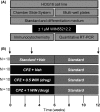The Cannabinoid CB1/CB2 Agonist WIN55212.2 Promotes Oligodendrocyte Differentiation In Vitro and Neuroprotection During the Cuprizone-Induced Central Nervous System Demyelination
- PMID: 26842941
- PMCID: PMC5067581
- DOI: 10.1111/cns.12506
The Cannabinoid CB1/CB2 Agonist WIN55212.2 Promotes Oligodendrocyte Differentiation In Vitro and Neuroprotection During the Cuprizone-Induced Central Nervous System Demyelination
Abstract
Aim and methods: Different types of insults to the CNS lead to axon demyelination. Remyelination occurs when the CNS attempts to recover from myelin loss and requires the activation of oligodendrocyte precursor cells. With the rationale that CB1 receptor is expressed in oligodendrocytes and marijuana consumption alters CNS myelination, we study the effects of the cannabinoid agonist WIN55212.2 in (1) an in vitro model of oligodendrocyte differentiation and (2) the cuprizone model for demyelination.
Results: The synthetic cannabinoid agonist WIN55212.2 at 1 μM increased the myelin basic protein mRNA and protein expression in vitro. During cuprizone-induced acute demyelination, the administration of 0.5 mg/kg WIN55212.2 confers more myelinated axons, increased the expression of retinoid X receptor alpha, and declined nogo receptor expression. Controversially, 1 mg/kg of the drug increased the number of demyelinated axons and reduced the expression of nerve growth factor inducible, calreticulin and myelin-related genes coupling specifically with a decrease in 2',3'-cyclic nucleotide 3' phosphodiesterase expression.
Conclusion: The cannabinoid agonist WIN55212.2 promotes oligodendrocyte differentiation in vitro. Moreover, 0.5 mg/kg of the drug confers neuroprotection during cuprizone-induced demyelination, while 1 mg/kg aggravates the demyelination process.
Keywords: Cuprizone; Demyelination; Endocannabinoid system; Neuroprotection; Oligodendrocyte.
© 2016 The Authors. CNS Neuroscience & Therapeutics published by John Wiley & Sons Ltd.
Conflict of interest statement
The authors declare no conflict of interest.
Figures




Similar articles
-
rHIgM22 enhances remyelination in the brain of the cuprizone mouse model of demyelination.Neurobiol Dis. 2017 Sep;105:142-155. doi: 10.1016/j.nbd.2017.05.015. Epub 2017 May 30. Neurobiol Dis. 2017. PMID: 28576706
-
Inactivation of Protein Tyrosine Phosphatase Receptor Type Z by Pleiotrophin Promotes Remyelination through Activation of Differentiation of Oligodendrocyte Precursor Cells.J Neurosci. 2015 Sep 2;35(35):12162-71. doi: 10.1523/JNEUROSCI.2127-15.2015. J Neurosci. 2015. PMID: 26338327 Free PMC article.
-
Dose-dependent effect of cannabinoid WIN-55,212-2 on myelin repair following a demyelinating insult.Sci Rep. 2020 Jan 17;10(1):590. doi: 10.1038/s41598-019-57290-1. Sci Rep. 2020. PMID: 31953431 Free PMC article.
-
De- and remyelination in the CNS white and grey matter induced by cuprizone: the old, the new, and the unexpected.Histol Histopathol. 2011 Dec;26(12):1585-97. doi: 10.14670/HH-26.1585. Histol Histopathol. 2011. PMID: 21972097 Review.
-
The neurotoxicant, cuprizone, as a model to study demyelination and remyelination in the central nervous system.Brain Pathol. 2001 Jan;11(1):107-16. doi: 10.1111/j.1750-3639.2001.tb00385.x. Brain Pathol. 2001. PMID: 11145196 Free PMC article. Review.
Cited by
-
Clemastine Promotes Differentiation of Oligodendrocyte Progenitor Cells Through the Activation of ERK1/2 via Muscarinic Receptors After Spinal Cord Injury.Front Pharmacol. 2022 Jul 5;13:914153. doi: 10.3389/fphar.2022.914153. eCollection 2022. Front Pharmacol. 2022. PMID: 35865954 Free PMC article.
-
Chronic exposure to cannabinoids during adolescence causes long-lasting behavioral deficits in adult mice.Addict Biol. 2017 Nov;22(6):1778-1789. doi: 10.1111/adb.12446. Epub 2016 Aug 31. Addict Biol. 2017. PMID: 27578457 Free PMC article.
-
Glial Cells and Their Contribution to the Mechanisms of Action of Cannabidiol in Neuropsychiatric Disorders.Front Pharmacol. 2021 Feb 4;11:618065. doi: 10.3389/fphar.2020.618065. eCollection 2020. Front Pharmacol. 2021. PMID: 33613284 Free PMC article. Review.
-
Sleep, Glial Function, and the Endocannabinoid System: Implications for Neuroinflammation and Sleep Disorders.Int J Mol Sci. 2024 Mar 9;25(6):3160. doi: 10.3390/ijms25063160. Int J Mol Sci. 2024. PMID: 38542134 Free PMC article. Review.
-
Spatial distribution of cannabinoid receptor type 1 (CB1) in normal canine central and peripheral nervous system.PLoS One. 2017 Jul 10;12(7):e0181064. doi: 10.1371/journal.pone.0181064. eCollection 2017. PLoS One. 2017. PMID: 28700706 Free PMC article.
References
-
- Baumann N, Pham‐Dinh D. Biology of oligodendrocyte and myelin in the mammalian central nervous system. Physiol Rev 2001;81:871–927. - PubMed
-
- Waxman SG. Axonal conduction and injury in multiple sclerosis: The role of sodium channels. Nat Rev Neurosci 2006;7:932–941. - PubMed
-
- Vettor R, Pagano C. The role of the endocannabinoid system in lipogenesis and fatty acid metabolism. Best Pract Res: Clin Endocrinol Metab 2009;23:51–63. - PubMed
Publication types
MeSH terms
Substances
LinkOut - more resources
Full Text Sources
Other Literature Sources
Research Materials

